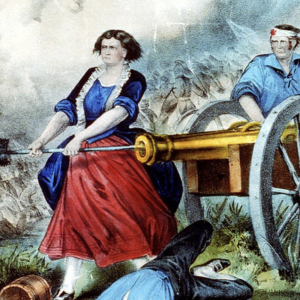The Revolutionary War may have been mostly fought by men, but women were an indispensable part of America’s fight for freedom.
You’ve heard of Abigail Adams and Betsy Ross, but how many other heroines do you know from our War of Independence? Test your knowledge with this short, easy and fun quiz.
1. When Mary Ludwig fearlessly manned a cannon in battle after her husband was hurt in combat at Monmouth, N.J., she earned this nickname:
A. Mary Long Guns
B. Molly Pitcher
C. Molly Maguire
D. Mary Canary
Answer: B. Though many women claimed to be “Molly Pitcher,” Ludwig’s story most closely matches the legend. “Molly” was a popular nickname for Mary, and Ludwig went to war with her barber husband William Hays, who served in the 4th Pennsylvania Infantry. A witness documented her replacing him in action after he was wounded.
2. This fearless frontierswoman wasn’t afraid to stand up to the half dozen British soldiers who invaded her rural Georgia home.
A. Nancy Hanks
B. Nancy Hart
C. Nancy Harmon
D. Nancy Davis
Answer: B. The Redcoats sought information about a Patriot they were seeking. They shot Nancy’s prized turkey and demanded that she cook it. Hart served the men wine and stalled until neighbors arrived and seized the soldiers; she then insisted they be hanged. In 1912, railroad workers unearthed six skeletons nearby.
3. Born in England, this woman married an American and settled in Philadelphia. She took up her adopted country’s cause so sincerely, she formed the “Ladies of Philadelphia,” who went door to door raising funds for the Patriot cause.
A. Elizabeth Arnold White
B. Edna St. Vincent Millay
C. Edwina St. George Cadwalder
D. Esther DeBerdt Reed
Answer: D. Raising the astronomical amount of $300,000, Reed urged Gen. George Washington to divide it among his troops. When he told her what his men really needed was clothing, it was used to buy linen and other material for shirts, and the ladies began sewing.
4. The occupation of New York City didn’t stop this brave woman, who secretly aided many American POWs passing through it. She may have also been a spy. When the British put a price on her head, she and her children were forced to flee to Philadelphia without their clothing or furniture.
A. Elizabeth Barrymore
B. Elizabeth Bates
C. Elizabeth Bertrand
D. Elizabeth Burgin
Answer: D. On Christmas Day 1779, Gen. Washington allowed Burgin to receive rations. (A very big deal when food was scarce.) She also received a pension for her wartime services from 1781 through at least 1787.
5. This woman was called “The Conscience of the American Revolution.”
A. Mary Helen Montgomery
B. Mercy Otis Warren
C. Mimi Eleanor Ridgeway
D. May Delight Campbell
Answer: B A published poet and playwright with an unusually high public profile for a woman of her time, Warren put her pen to work writing on behalf of American independence.
6. Though her husband, Henry, was a famous general remembered as “The Father of American Artillery,” this woman turned her back on her Loyalist relatives and was at her partner’s side in the field during the entire Revolution, including the brutal winter at Valley Forge.
A. Leona Smucker Adams
B. Fiona Drucker O’Toole
C. Lucy Flucker Knox
D. Amanda Plucker Simpson
Answer: C. Affectionately called “Lady Knox” by the soldiers, she worked tirelessly to support them. Kentucky’s Fort Knox is named in Henry’s honor.
7. Much like Molly Pitcher, this brave woman saw her husband fall in action, rushed to replace him on a cannon crew, and was then wounded herself.
A. Margaret Cochran Corbin
B. Mary Ernst Edelwill
C. Minnie Frances Finwall
D. Maggie Wilson Witherspoon
Answer: A. As a nurse, Corbin was allowed to follow her husband into action when the British attacked Manhattan’s Fort Washington in 1776. Seeing a gunner fall, the husband raced to the cannon to replace him. When he, too, went down, Margaret filled his place, only to be hit in the jaw, chest and arm by British fire. Corbin’s wounds plagued her for the rest of her life.





